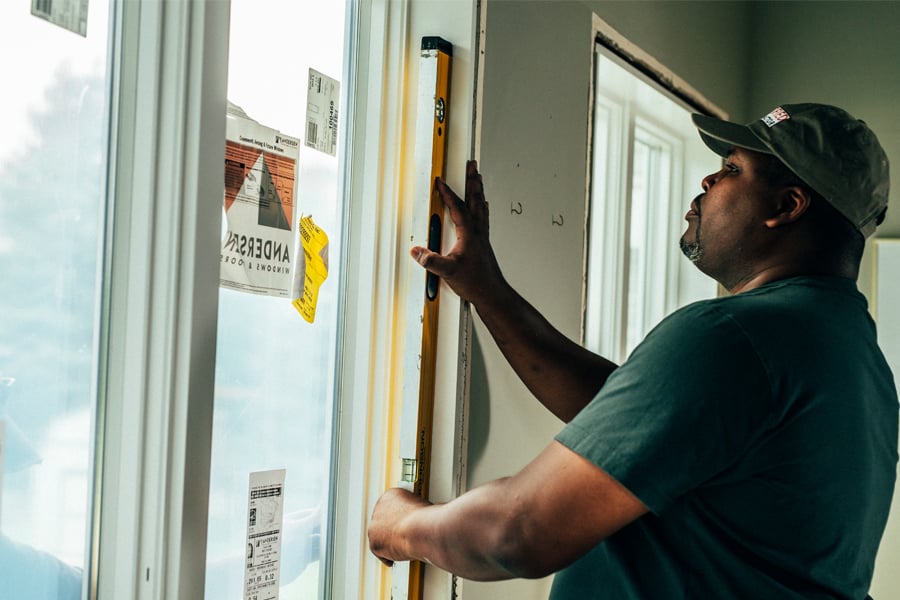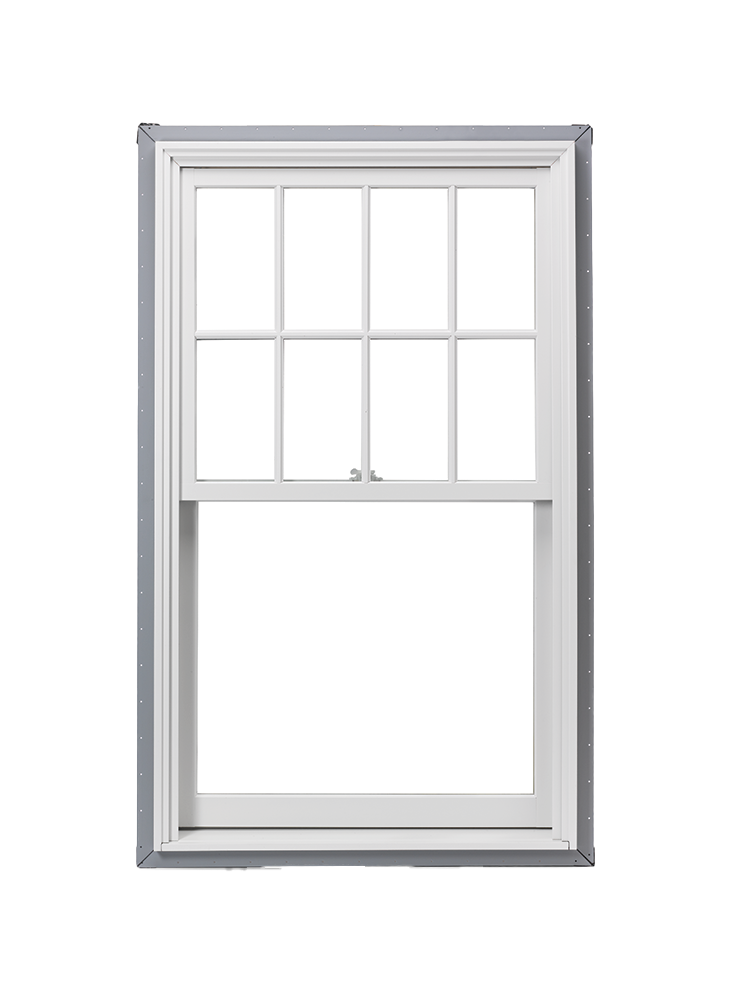Tips
New construction vs. replacement windows: Which is right for your project?

If you’re building a new construction home, the answer to which window is best is simple: a flanged full-frame window (commonly called a “new construction” window). If you’re replacing or remodeling your home, there’s more to consider, because either a new construction window or a replacement-specific window (full-frame or insert) could work. We’ll walk you through the considerations as you’re evaluating new construction versus replacement windows, so you can make the choice that best suits your project.
What are the three main types of window installations?
There are three different ways that windows can be installed. We’ll explain why you might choose a flanged full-frame window, flangeless full-frame window, or an insert replacement window.
1. A flanged full-frame window is ideal for new construction and major remodels
In a new construction build or major remodel where new walls are being built, a flanged full-frame window is ideal This window is made for installing before siding and trim due to its nailing fin, which we refer to as a nailing flange or installation flange. This vinyl lip runs around the perimeter of the window frame and comes with predrilled holes for installation.

2. A flangeless full-frame window is ideal for replacement projects where the opening will remain the same
In a smaller remodel or a window in/window out replacement project, a flangeless full-frame replacement is one good option. The reason it works well for an existing opening is that it doesn’t have a nailing fin, like a flanged full-frame window does. This means its installation won't require peeling back siding and removing trim. A flangeless full-frame window does come with a new frame around it, so the old window and old frame will be removed, and the new window will be installed inside the existing opening. This is a less invasive option than installing a flangeless full-frame window (“new construction”) as it will also allow you to preserve your trim and siding.

3. An insert replacement window is a simple solution for window in/window out projects
In a project where you are just removing old windows and installing new ones, and no other home improvements are included, an insert replacement window can be ideal. It has neither a nailing fin nor a new frame. It’s installed by removing the old sash (glass and framing around it) and reusing the existing window frame. This makes it the least disruptive replacement option and, like a flangeless full-frame, allows you to keep siding and trim. It’s important to know that an insert replacement window can only be used when your existing frame is in good condition, and there are no issues with leaking air or water.
Psst ... If an insert won’t work for your window in/window out project, a full-frame flangeless window is another option that comes with a less disruptive installation.

Which window type does your project need? A quick guide
Get a quick answer to which option is best in a couple of the most common replacement scenarios.
Windows for a new construction home
When you are building a new home, you’ll want a flanged full-frame window. The flange (or nailing fin) makes the window quick to install and also makes it easier to install in a way that seals against the elements.
Windows for an addition or major remodel
When you’re undertaking an addition that involves building new walls, you will, again, want to choose a flanged full-frame window. It’s the quickest to install and makes it easy to connect control layers. This is how the pros describe the steps taken to manage water, air, vapor and thermal energy, or more simply put, protect the house from the elements.
Windows for remodeling or replacing siding
When you are remodeling or replacing siding, you once again have the option to replace with a flanged full-frame window, which is installed before siding and trim. The nailing fin makes this window easier to install and easier to connect with the drainage plane, which is the part of the wall that encourages water to drain away, rather than into, the home.
Windows for when your frames are in good shape, but the glass is damaged or outdated
When your window frames are in good shape but the glass is damaged or outdated, you could choose an insert replacement window. The frame must be in good condition for this type of installation. In addition, you'll want to be confident there are no issues with leaking water or air because you’re relying on existing systems to keep these elements out of the home.
Windows for when frames are rotted, warped, or no longer square
When your window frames are rotted, warped, or no longer square, you will likely pick a full-frame replacement window. This will allow you to replace the problematic frame without disturbing your siding or trim. However, you could select a flanged full-frame window too. The second option will work if you are able to peel back the siding or trim and are willing to take on a project with a larger scope and more expensive window units.
New construction vs. Replacement windows: A detailed comparison
Window installation considerations
A flanged full-frame window has a nailing fin (or flange) that means it must be installed before the siding. This is easily done in a new construction project. In a replacement project, it can be done where it’s possible to peel back the siding or alternatively, where a buck can be built. A buck is a structurally sound frame that is built inside the rough opening, which is the hole in the wall where a window or door is installed.
A full-frame replacement window is one that fits inside an existing rough opening, after the old window and frame have been removed. This type of window doesn’t require removing siding or trim, so it’s less invasive than the installation of a flanged full-frame window.
An insert replacement window fits inside an existing window frame, so it’s the least disruptive window replacement option. Siding, trim, and the existing frame all remain. None of the finishing details that can add time, labor, and costs will be needed here.
Window replacement cost comparison
Flanged full-frame and flangeless full-frame windows will be more expensive than insert replacement windows. This is because insert replacement windows are the simplest window units from the perspective of materials and manufacturing. Keep in mind the window unit is only one aspect of pricing; the installation costs associated with flanged full-frame windows will be higher because of the finishing required to replace trim and siding.
Window energy efficiency
A flanged full-frame window is easiest to install in a way that ensures it performs as efficiently as intended. This is because of the nailing fin, which makes it easy to flash. This is how the window is connected with the control layers. Remember, this is how pros describe the systems put in place to keep outside elements out and inside air in.
This doesn’t mean the other options don’t offer energy efficiency. A full-frame replacement window is sealed on the exterior side when it's installed, and an insert replacement window relies on the existing systems for managing the elements.
If you have concerns about your existing windows leaking air, you will want to opt for a full-frame replacement window or a flanged full-frame window, as both options will give you the opportunity to install in a way that will improve energy efficiency, rather than relying on existing systems.
Aesthetic impact of windows
There are several different ways to think about the aesthetic impact of choosing one of these window options over another. Here are some questions to ask yourself:
- Are you replacing all your windows or only a few? If you are only replacing a few windows and don’t have firm plans to replace all windows, you might be best off using a replacement option that will allow you to keep your existing trim, so a full-frame or insert window.
- Do you have special trim in your home? If you live in a home with beautiful, traditional wood trim, you understandably might not want to lose this aspect of your home’s character. Either a full-frame or insert window will allow for the trim to be preserved.
- Do you want the most daylight possible? If so, you should be aware that insert replacement windows, by fitting inside the existing frame, will cut down somewhat on the amount of daylight inside your home.
The best way to decide on the right replacement option for your home will be to speak with a contractor who is experienced in window and door replacement. We can help you find a pro in your area who specializes in our products.
Frequently asked questions
Can I use new construction windows for a replacement project?
Yes, you can use a flanged full-frame window in a replacement project. These windows are casually referred to as “new construction” windows because they’re ideal for that type of project, but they can also be used in replacement projects. Because this type of window has a nailing fin (or flange), they’re either installed after the siding has been peeled back or inside a buck, which is frame that can be built into a rough opening.
Do replacement windows have nailing fins?
No, this feature is specific to flanged full-frame windows (“new construction” windows). Flangeless full-frame and insert replacement windows can be installed without this feature.
When is a full-frame replacement necessary?
A flangeless full-frame replacement window will be necessary if your existing window frame is not in good condition, i.e. it’s rotten, warped, or out of square. It will also be needed if there is air or water leaking into the home. This is because an insert replacement relies on existing systems for managing against these elements.
Why are new construction windows sometimes cheaper?
When we talk about “new construction” windows, we are referring to flanged full-frame windows. They are more expensive than insert replacement windows, because they are more complex window units requiring more materials and manufacturing steps. However, there is sometimes a discount offered when more windows are purchased at once. So, for a full-home window replacement project, you might get a certain percentage off from your retailer or dealer.
How do I measure for replacement vs. new construction windows?
This is a good question and it’s not a simple one to answer. Whether you are measuring for a replacement window (flangeless full-frame or insert) or a new construction window (flanged full-frame), we recommend leaving this task to an experienced contractor, unless you have extensive experience in window and door replacement yourself. This is because the precise measuring needed to order the correct size of windows will depend on existing conditions and is likely to require judgement calls, which will be best made by an experienced pro, rather than a DIYer.
Still, if you are looking for high-level instructions, we can explain how to measure windows in a way that will give you enough information to start comparison shopping — looking at how one size window compares to another from a different product line or made by a different manufacturer.
